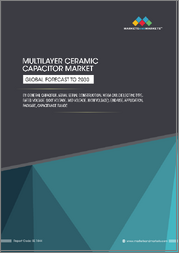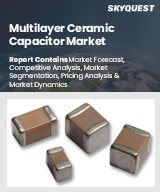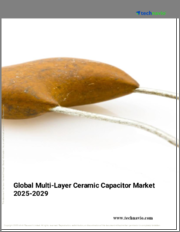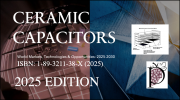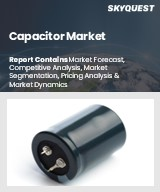
|
시장보고서
상품코드
1573205
세계의 세라믹 커패시터 시장 : 유형, 용도, 최종사용자 산업, 용량, 전압 범위, 유전체 유형별 예측(2025-2030년)Ceramic Capacitors Market by Type, Application, End-User Industry, Capacity, Voltage Range, Dielectric Type - Global Forecast 2025-2030 |
||||||
세라믹 커패시터 시장은 2023년에 10억 2,000만 달러로 평가되었고, 2024년에는 10억 8,000만 달러에 도달할 것으로 예측되며, CAGR 11.38%로 성장해 2030년에는 21억 7,000만 달러에 달할 것으로 예측됩니다.
세라믹 커패시터, 전자 회로의 주요 부품은 전기 에너지 저장 및 방출에 매우 중요합니다. 그 용도는 필터링, 바이패스, 커플링 등 다양한 분야에서 통신, 자동차, 가전, 산업기계 등의 분야에 응용되고 있습니다. 전자기기의 소형화 및 사용 빈도 증가의 동향은 커패시터의 필요성을 높여주고 있으며, 효율적인 에너지 처리에 있어서 매우 중요한 역할을 담당하고 있습니다. 최종 용도 부문은 광범위하게 전자기기 제조, 특히 EV의 보급이 진행되는 자동차, 커패시터가 전력 저장 및 배전 시스템을 지원하는 재생 가능 에너지원을 포함하고 있습니다.
| 주요 시장 통계 | |
|---|---|
| 기준년(2023) | 10억 2,000만 달러 |
| 예측년(2024) | 10억 8,000만 달러 |
| 예측년(2030) | 21억 7,000만 달러 |
| CAGR(%) | 11.38% |
주요 성장 요인으로는 전자의 급속한 기술 진보, 고속 데이터 처리에 대한 수요의 급증, IoT 기기의 폭발적인 증가 등을 들 수 있으며, 소형이면서 고효율 부품에 대한 요구가 높아지고 있습니다. 그러나 시장 성장의 과제는 원재료 가격 변동과 제품 소형화를 둘러싼 복잡성입니다. 또한 환경 규제와 환경 친화적 인 부품을 제조하도록 제조업체에 요구하는 압력도 장애물입니다.
시장 기회는 재생 가능 에너지 시스템, 특히 에너지 저장 솔루션에 견고한 커패시터를 필요로 하는 태양광 발전 및 풍력 발전에 풍부합니다. 전동화로의 전환이 진행되는 자동차 분야에서는 고성능 EV 배터리와 파워트레인 시스템용으로 설계된 특수한 세라믹 커패시터에 활로가 있습니다. 이해관계자들은 효과적으로 이익을 얻기 위해 높은 커패시턴스, 낮은 ESR 세라믹 재료 개발, 혹독한 환경에서의 성능 향상을 위한 유전 특성 강화 등의 연구 분야에 주력해야 합니다. 시장 경쟁은 기술 혁신과 전략적 제휴에 달려 있습니다.
그러므로 R&D 투자와 지속가능한 제조방법의 개발은 신뢰성과 효율성이 가장 중요한 항공우주 및 방위와 같은 특수 용도의 개척과 함께 성장을 가속할 수 있습니다. 이러한 제약에 대처하고 혁신을 최적화함으로써 기업은 세라믹 커패시터의 잠재 능력을 최대한 활용하고 미래의 기술 진화에 대응할 수 있어 시장에서의 지속적인 존재감과 확대를 확보할 수 있습니다.
시장 역학: 빠르게 진화하는 세라믹 커패시터 시장의 주요 시장 인사이트 공개
세라믹 커패시터 시장은 수요 및 공급의 역동적인 상호 작용에 의해 변모를 이루고 있습니다. 이러한 시장 역학의 진화를 이해함으로써 기업은 충분한 정보를 바탕으로 투자결정, 전략적 결정 정밀화, 새로운 비즈니스 기회 획득에 대비할 수 있습니다. 이러한 동향을 종합적으로 파악함으로써 기업은 정치적, 지리적, 기술적, 사회적, 경제적인 영역에 걸친 다양한 리스크를 경감할 수 있음과 동시에, 소비자 행동과 그것이 제조 비용이나 구매 동향에 미치는 영향을 보다 명확하게 이해할 수 있습니다.
- 시장 성장 촉진요인
- 컴팩트하고 내구성이 요구되는 사물인터넷(IoT) 기기의 통합 확대 세라믹 커패시터
- 고주파 세라믹 커패시터 수요 증가로 이어지는 통신 인프라의 확대
- 웨어러블 기술이나 휴대용 디바이스 증가에 의해 소형이고 효율적인 세라믹 커패시터의 사용이 필요
- 의료용 일렉트로닉스의 진보에 의해 신뢰성이 높고 고성능인 세라믹 커패시터 수요가 대폭 증가
- 시장 성장 억제요인
- 세라믹 커패시터의 성능을 유지하면서 소형화를 달성하기 위한 기술적 한계
- 세라믹 커패시터의 생산과 유통에 영향을 미치는 복잡한 규제 준수 및 인증 프로세스
- 시장 기회
- 전기자동차에 있어서의 에너지 효율이 높은 전원 관리를 위한 세라믹 커패시터 수요 증가
- 성능 향상과 소형화를 목적으로 한 고도 통신에 있어서의 다층 세라믹 커패시터의 채용 확대
- IoT 디바이스의 확대에 의한, 신뢰성이 높은 접속성을 실현하는 대용량 세라믹 커패시터의 필요성
- 시장의 과제
- 세계 세라믹 커패시터 수요 증가에 대응하기 위한 제조 공정 최적화
- 세라믹 커패시터 시장에 있어서의 세계의 혼란과 재료 부족 속에서공급 체인의 회복력의 확보
Porter's Five Forces: 세라믹 커패시터 시장을 탐색하는 전략 도구
Portre's Five Forces 프레임워크는 세라믹 커패시터 시장 경쟁 구도를 이해하기 위한 중요한 도구입니다. 한 기술을 제공합니다. K는 기업이 시장 내 세력도를 평가하고 신규 사업의 수익성을 판단하는 데 도움이 됩니다. 를 피할 수 있으며 더 강인한 시장에서 포지셔닝을 보장 할 수 있습니다.
PESTLE 분석 : 세라믹 커패시터 시장에서 외부로부터의 영향 파악
외부 거시 환경 요인은 세라믹 커패시터 시장의 성과 역학을 형성하는데 매우 중요한 역할을합니다. 를 탐색하는 데 필요한 정보 제공 PESTLE 요인을 조사함으로써 기업은 잠재적인 위험과 기회를 더 잘 이해할 수 있습니다. 앞을 내다본 적극적인 의사결정을 할 준비가 되어 있습니다.
시장 점유율 분석 : 세라믹 커패시터 시장 경쟁 구도 파악
세라믹 커패시터 시장의 상세한 시장 점유율 분석을 통해 공급업체의 성과를 종합적으로 평가할 수 있습니다. 명 부드럽게 할 수 있습니다.이 분석은 시장 집중, 단편화 및 통합 동향을 명확히하고 벤더는 경쟁이 치열 해짐에 따라 자사의 지위를 높이는 전략적 의사 결정을 내리는 데 필요합니다. 지식을 얻을 수 있습니다.
FPNV 포지셔닝 매트릭스 : 세라믹 커패시터 시장에서 공급업체의 성능 평가
FPNV 포지셔닝 매트릭스는 세라믹 커패시터 시장에서 공급업체를 평가하는 중요한 도구입니다. 이 행렬을 통해 비즈니스 조직은 공급업체의 비즈니스 전략과 제품 만족도를 기준으로 평가하여 목표에 맞는 충분한 정보를 바탕으로 의사 결정을 내릴 수 있습니다. 네 가지 사분면을 통해 공급업체를 명확하고 정확하게 세분화하여 전략 목표에 가장 적합한 파트너 및 솔루션을 파악할 수 있습니다.
전략 분석 및 권장 : 세라믹 커패시터 시장에서 성공에 대한 길을 그립니다.
세라믹 커패시터 시장의 전략 분석은 세계 시장에서의 존재를 강화하려는 기업에게 필수적입니다. 주요 자원, 능력 및 성과 지표를 검토함으로써 기업은 성장 기회를 파악하고 개선을 위해 노력할 수 있습니다. 이러한 접근 방식을 통해 경쟁 구도에서 과제를 극복하고 새로운 비즈니스 기회를 활용하여 장기적인 성공을 거둘 수 있는 체제를 구축할 수 있습니다.
이 보고서는 주요 관심 분야를 포괄하는 시장의 종합적인 분석을 제공합니다.
1. 시장 침투: 현재 시장 환경의 상세한 검토, 주요 기업의 광범위한 데이터, 시장 도달범위 및 전반적인 영향력 평가.
2. 시장 개척도: 신흥 시장의 성장 기회를 파악하고 기존 분야의 확장 가능성을 평가하며 미래 성장을 위한 전략적 로드맵을 제공합니다.
3. 시장 다양화: 최근 제품 출시, 미개척 지역, 업계의 주요 진보, 시장을 형성하는 전략적 투자를 분석합니다.
4. 경쟁 평가 및 정보 : 경쟁 구도를 철저히 분석하여 시장 점유율, 사업 전략, 제품 포트폴리오, 인증, 규제 당국 승인, 특허 동향, 주요 기업의 기술 진보 등을 검증합니다.
5. 제품 개발 및 혁신 : 미래 시장 성장을 가속할 것으로 예상되는 최첨단 기술, R&D 활동, 제품 혁신을 강조합니다.
또한 이해관계자가 충분한 정보를 얻고 의사결정을 할 수 있도록 중요한 질문에 대답하고 있습니다.
1. 현재 시장 규모와 향후 성장 예측은?
2. 최고의 투자 기회를 제공하는 제품, 부문 및 지역은 어디입니까?
3. 시장을 형성하는 주요 기술 동향과 규제의 영향은?
4. 주요 벤더의 시장 점유율과 경쟁 포지션은?
5. 벤더 시장 진입·철수 전략의 원동력이 되는 수익원과 전략적 기회는 무엇인가?
목차
제1장 서문
제2장 조사 방법
제3장 주요 요약
제4장 시장 개요
제5장 시장 인사이트
- 시장 역학
- 성장 촉진요인
- 컴팩트하고 내구성있는 사물 인터넷(IoT) 디바이스 통합 증가 세라믹 커패시터
- 통신 인프라 확대로 고주파수 세라믹 커패시터 수요 증가
- 웨어러블 기술과 휴대용 디바이스 증가로 인해 작고 효율적인 세라믹 커패시터의 사용이 필요합니다.
- 의료용 전자기기의 발전으로 신뢰성과 고성능 수요가 크게 증가하고 있습니다.
- 억제요인
- 세라믹 커패시터의 퍼포먼스를 유지하면서 소형화를 실현하는 기술적 한계
- 세라믹 커패시터의 생산과 유통에 영향을 미치는 복잡한 규제 준수 및 인증 프로세스
- 기회
- 에너지 효율이 높은 전력 관리를 위한 전기자동차에 있어서의 세라믹 커패시터 수요 증가
- 고성능화와 소형화를 위해, 선진적인 통신 분야에서는 다층 세라믹 커패시터의 채용이 확대
- IoT 디바이스의 확대로 신뢰성 높은 접속을 위한 대용량 세라믹 커패시터의 필요성 증가
- 과제
- 세계에서 증가하는 세라믹 커패시터 수요에 부응하기 위해 제조 공정을 최적화
- 세계의 혼란과 원재료 부족 속에서 공급 체인의 회복력을 확보하는 세라믹 커패시터 시장
- 성장 촉진요인
- 시장 세분화 분석
- Porter's Five Forces 분석
- PESTLE 분석
- 정치적
- 경제
- 사교
- 기술적
- 법률상
- 환경
제6장 세라믹 커패시터 시장 : 유형별
- 세라믹 디스크 커패시터
- 범용
- 고전압
- 저전압
- 다층 세라믹 칩 커패시터
- 범용
- 고전압
- 저전압
- 단층 세라믹 커패시터
- 범용
- 고전압
- 저전압
제7장 세라믹 커패시터 시장 : 용도별
- 자동차
- 전기자동차
- 하이브리드 자동차
- 가전
- 노트북 PC
- 스마트폰
- 태블릿
- 산업기계
- 제조설비
- 의료기기
제8장 세라믹 커패시터 시장 : 최종 사용 산업별
- 방어 및 항공우주
- 항공전자기기
- 군사통신
- 헬스케어
- 진단 기기
- 환자 모니터링 시스템
- 통신
- 네트워크 기기
- 위성통신
제9장 세라믹 커패시터 시장 : 용량별
- 대용량
- 저용량
- 중용량
제10장 세라믹 커패시터 시장 : 전압 범위별
- 0-50V
- 101-500V
- 51-100V
- 500V 이상
제11장 세라믹 커패시터 시장 : 유전체 유형별
- 클래스 I
- 클래스 II
- 클래스 III
제12장 아메리카의 세라믹 커패시터 시장
- 아르헨티나
- 브라질
- 캐나다
- 멕시코
- 미국
제13장 아시아태평양의 세라믹 커패시터 시장
- 호주
- 중국
- 인도
- 인도네시아
- 일본
- 말레이시아
- 필리핀
- 싱가포르
- 한국
- 대만
- 태국
- 베트남
제14장 유럽·중동 및 아프리카의 세라믹 커패시터 시장
- 덴마크
- 이집트
- 핀란드
- 프랑스
- 독일
- 이스라엘
- 이탈리아
- 네덜란드
- 나이지리아
- 노르웨이
- 폴란드
- 카타르
- 러시아
- 사우디아라비아
- 남아프리카
- 스페인
- 스웨덴
- 스위스
- 터키
- 아랍에미리트(UAE)
- 영국
제15장 경쟁 구도
- 시장 점유율 분석, 2023년
- FPNV 포지셔닝 매트릭스, 2023년
- 경쟁 시나리오 분석
- 전략 분석과 제안
The Ceramic Capacitors Market was valued at USD 1.02 billion in 2023, expected to reach USD 1.08 billion in 2024, and is projected to grow at a CAGR of 11.38%, to USD 2.17 billion by 2030.
Ceramic capacitors, key components in electronic circuits, are pivotal for storing and releasing electrical energy. Their scope spans diverse functionalities such as filtering, bypassing, and coupling, with applications in sectors like telecommunications, automotive, consumer electronics, and industrial machinery. The growing trend towards miniaturization and increased frequency of usage in electronics escalate the necessity for these capacitors, underscoring their pivotal role in efficient energy handling. The end-use sector is broad, encompassing electronics manufacturing; automotive, particularly with the rise in EV adoption; and renewable energy sources, where capacitors support power storage and distribution systems.
| KEY MARKET STATISTICS | |
|---|---|
| Base Year [2023] | USD 1.02 billion |
| Estimated Year [2024] | USD 1.08 billion |
| Forecast Year [2030] | USD 2.17 billion |
| CAGR (%) | 11.38% |
Key growth influencers include the rapid technological advancements in electronics, burgeoning demands for high-speed data processing, and the explosive growth in IoT devices, driving up the need for components that are compact yet highly efficient. However, market growth is challenged by raw material price volatility and the complexities surrounding product miniaturization. Environmental regulations and pressure on manufacturers to produce eco-friendlier components also pose as hurdles.
Market opportunities abound in renewable energy systems, particularly solar and wind, which require robust capacitors for energy storage solutions. The automotive sector, with a shift towards electrification, presents avenues for specialized ceramic capacitors designed for high-performance EV batteries and powertrain systems. To capitalize effectively, stakeholders should focus on research areas such as developing high-capacitance, low-ESR ceramic materials, and enhancing dielectric properties to boost performance in harsh environments. The market's competitive nature hinges on technological innovations and strategic collaborations.
Thus, investing in R&D and developing sustainable manufacturing practices could foster growth, alongside exploring specialized applications like aerospace and defense, where reliability and efficiency are paramount. By addressing these limitations and optimizing innovation, businesses can harness ceramic capacitors' full potential and align with future tech evolutions, ensuring sustained market presence and expansion.
Market Dynamics: Unveiling Key Market Insights in the Rapidly Evolving Ceramic Capacitors Market
The Ceramic Capacitors Market is undergoing transformative changes driven by a dynamic interplay of supply and demand factors. Understanding these evolving market dynamics prepares business organizations to make informed investment decisions, refine strategic decisions, and seize new opportunities. By gaining a comprehensive view of these trends, business organizations can mitigate various risks across political, geographic, technical, social, and economic domains while also gaining a clearer understanding of consumer behavior and its impact on manufacturing costs and purchasing trends.
- Market Drivers
- Growing integration of internet of things (IoT) devices requiring compact and durable ceramic capacitors
- Expansion of telecommunications infrastructure leading to higher demand for ceramic capacitors with high frequency
- Increase in wearable technology and portable devices necessitates the use of miniature and efficient ceramic capacitors
- Advancements in medical electronics significantly driving the demand for reliable and high-performance ceramic capacitors
- Market Restraints
- Technical limitations in achieving miniaturization while maintaining performance in ceramic capacitors
- Complex regulatory compliance and certification processes affecting ceramic capacitor production and distribution
- Market Opportunities
- Increasing demand for ceramic capacitors in electric vehicles for energy-efficient power management
- Growing adoption of multilayer ceramic capacitors in advanced telecommunications for better performance and miniaturization
- Expansion of IoT devices driving the need for high-capacity ceramic capacitors for reliable connectivity
- Market Challenges
- Optimizing manufacturing processes to meet the increasing demand for ceramic capacitors globally
- Ensuring supply chain resilience amidst global disruptions and material shortages in the ceramic capacitors market
Porter's Five Forces: A Strategic Tool for Navigating the Ceramic Capacitors Market
Porter's five forces framework is a critical tool for understanding the competitive landscape of the Ceramic Capacitors Market. It offers business organizations with a clear methodology for evaluating their competitive positioning and exploring strategic opportunities. This framework helps businesses assess the power dynamics within the market and determine the profitability of new ventures. With these insights, business organizations can leverage their strengths, address weaknesses, and avoid potential challenges, ensuring a more resilient market positioning.
PESTLE Analysis: Navigating External Influences in the Ceramic Capacitors Market
External macro-environmental factors play a pivotal role in shaping the performance dynamics of the Ceramic Capacitors Market. Political, Economic, Social, Technological, Legal, and Environmental factors analysis provides the necessary information to navigate these influences. By examining PESTLE factors, businesses can better understand potential risks and opportunities. This analysis enables business organizations to anticipate changes in regulations, consumer preferences, and economic trends, ensuring they are prepared to make proactive, forward-thinking decisions.
Market Share Analysis: Understanding the Competitive Landscape in the Ceramic Capacitors Market
A detailed market share analysis in the Ceramic Capacitors Market provides a comprehensive assessment of vendors' performance. Companies can identify their competitive positioning by comparing key metrics, including revenue, customer base, and growth rates. This analysis highlights market concentration, fragmentation, and trends in consolidation, offering vendors the insights required to make strategic decisions that enhance their position in an increasingly competitive landscape.
FPNV Positioning Matrix: Evaluating Vendors' Performance in the Ceramic Capacitors Market
The Forefront, Pathfinder, Niche, Vital (FPNV) Positioning Matrix is a critical tool for evaluating vendors within the Ceramic Capacitors Market. This matrix enables business organizations to make well-informed decisions that align with their goals by assessing vendors based on their business strategy and product satisfaction. The four quadrants provide a clear and precise segmentation of vendors, helping users identify the right partners and solutions that best fit their strategic objectives.
Strategy Analysis & Recommendation: Charting a Path to Success in the Ceramic Capacitors Market
A strategic analysis of the Ceramic Capacitors Market is essential for businesses looking to strengthen their global market presence. By reviewing key resources, capabilities, and performance indicators, business organizations can identify growth opportunities and work toward improvement. This approach helps businesses navigate challenges in the competitive landscape and ensures they are well-positioned to capitalize on newer opportunities and drive long-term success.
Key Company Profiles
The report delves into recent significant developments in the Ceramic Capacitors Market, highlighting leading vendors and their innovative profiles. These include AVX Corporation, Darfon Electronics Corporation, Eaton Corporation plc, Holy Stone Enterprise Co., Ltd., Johanson Dielectrics, Inc., KEMET Corporation, Knowles Precision Devices, Kyocera Corporation, Murata Manufacturing Co., Ltd., NIC Components Corp., Nippon Chemi-Con Corporation, Panasonic Corporation, Samsung Electro-Mechanics, Sunlord Electronics Co., Ltd., Taiyo Yuden Co., Ltd., TDK Corporation, Vishay Intertechnology, Inc., Walsin Technology Corporation, Wurth Elektronik Group, and Yageo Corporation.
Market Segmentation & Coverage
This research report categorizes the Ceramic Capacitors Market to forecast the revenues and analyze trends in each of the following sub-markets:
- Based on Type, market is studied across Ceramic Disc Capacitors, Multilayered Ceramic Chip Capacitors, and Single Layer Ceramic Capacitors. The Ceramic Disc Capacitors is further studied across General Purpose, High Voltage, and Low Voltage. The Multilayered Ceramic Chip Capacitors is further studied across General Purpose, High Voltage, and Low Voltage. The Single Layer Ceramic Capacitors is further studied across General Purpose, High Voltage, and Low Voltage.
- Based on Application, market is studied across Automotive, Consumer Electronics, and Industrial Machinery. The Automotive is further studied across Electric Vehicles and Hybrid Vehicles. The Consumer Electronics is further studied across Laptops, Smartphones, and Tablets. The Industrial Machinery is further studied across Manufacturing Equipment and Medical Equipment.
- Based on End-User Industry, market is studied across Defense And Aerospace, Healthcare, and Telecommunications. The Defense And Aerospace is further studied across Avionics and Military Communication. The Healthcare is further studied across Diagnostic Equipment and Patient Monitoring Systems. The Telecommunications is further studied across Networking Equipment and Satellite Communication.
- Based on Capacity, market is studied across High Capacity, Low Capacity, and Medium Capacity.
- Based on Voltage Range, market is studied across 0-50V, 101-500V, 51-100V, and Above 500V.
- Based on Dielectric Type, market is studied across Class I, Class II, and Class III.
- Based on Region, market is studied across Americas, Asia-Pacific, and Europe, Middle East & Africa. The Americas is further studied across Argentina, Brazil, Canada, Mexico, and United States. The United States is further studied across California, Florida, Illinois, New York, Ohio, Pennsylvania, and Texas. The Asia-Pacific is further studied across Australia, China, India, Indonesia, Japan, Malaysia, Philippines, Singapore, South Korea, Taiwan, Thailand, and Vietnam. The Europe, Middle East & Africa is further studied across Denmark, Egypt, Finland, France, Germany, Israel, Italy, Netherlands, Nigeria, Norway, Poland, Qatar, Russia, Saudi Arabia, South Africa, Spain, Sweden, Switzerland, Turkey, United Arab Emirates, and United Kingdom.
The report offers a comprehensive analysis of the market, covering key focus areas:
1. Market Penetration: A detailed review of the current market environment, including extensive data from top industry players, evaluating their market reach and overall influence.
2. Market Development: Identifies growth opportunities in emerging markets and assesses expansion potential in established sectors, providing a strategic roadmap for future growth.
3. Market Diversification: Analyzes recent product launches, untapped geographic regions, major industry advancements, and strategic investments reshaping the market.
4. Competitive Assessment & Intelligence: Provides a thorough analysis of the competitive landscape, examining market share, business strategies, product portfolios, certifications, regulatory approvals, patent trends, and technological advancements of key players.
5. Product Development & Innovation: Highlights cutting-edge technologies, R&D activities, and product innovations expected to drive future market growth.
The report also answers critical questions to aid stakeholders in making informed decisions:
1. What is the current market size, and what is the forecasted growth?
2. Which products, segments, and regions offer the best investment opportunities?
3. What are the key technology trends and regulatory influences shaping the market?
4. How do leading vendors rank in terms of market share and competitive positioning?
5. What revenue sources and strategic opportunities drive vendors' market entry or exit strategies?
Table of Contents
1. Preface
- 1.1. Objectives of the Study
- 1.2. Market Segmentation & Coverage
- 1.3. Years Considered for the Study
- 1.4. Currency & Pricing
- 1.5. Language
- 1.6. Stakeholders
2. Research Methodology
- 2.1. Define: Research Objective
- 2.2. Determine: Research Design
- 2.3. Prepare: Research Instrument
- 2.4. Collect: Data Source
- 2.5. Analyze: Data Interpretation
- 2.6. Formulate: Data Verification
- 2.7. Publish: Research Report
- 2.8. Repeat: Report Update
3. Executive Summary
4. Market Overview
5. Market Insights
- 5.1. Market Dynamics
- 5.1.1. Drivers
- 5.1.1.1. Growing integration of internet of things (IoT) devices requiring compact and durable ceramic capacitors
- 5.1.1.2. Expansion of telecommunications infrastructure leading to higher demand for ceramic capacitors with high frequency
- 5.1.1.3. Increase in wearable technology and portable devices necessitates the use of miniature and efficient ceramic capacitors
- 5.1.1.4. Advancements in medical electronics significantly driving the demand for reliable and high-performance ceramic capacitors
- 5.1.2. Restraints
- 5.1.2.1. Technical limitations in achieving miniaturization while maintaining performance in ceramic capacitors
- 5.1.2.2. Complex regulatory compliance and certification processes affecting ceramic capacitor production and distribution
- 5.1.3. Opportunities
- 5.1.3.1. Increasing demand for ceramic capacitors in electric vehicles for energy-efficient power management
- 5.1.3.2. Growing adoption of multilayer ceramic capacitors in advanced telecommunications for better performance and miniaturization
- 5.1.3.3. Expansion of IoT devices driving the need for high-capacity ceramic capacitors for reliable connectivity
- 5.1.4. Challenges
- 5.1.4.1. Optimizing manufacturing processes to meet the increasing demand for ceramic capacitors globally
- 5.1.4.2. Ensuring supply chain resilience amidst global disruptions and material shortages in the ceramic capacitors market
- 5.1.1. Drivers
- 5.2. Market Segmentation Analysis
- 5.3. Porter's Five Forces Analysis
- 5.3.1. Threat of New Entrants
- 5.3.2. Threat of Substitutes
- 5.3.3. Bargaining Power of Customers
- 5.3.4. Bargaining Power of Suppliers
- 5.3.5. Industry Rivalry
- 5.4. PESTLE Analysis
- 5.4.1. Political
- 5.4.2. Economic
- 5.4.3. Social
- 5.4.4. Technological
- 5.4.5. Legal
- 5.4.6. Environmental
6. Ceramic Capacitors Market, by Type
- 6.1. Introduction
- 6.2. Ceramic Disc Capacitors
- 6.2.1. General Purpose
- 6.2.2. High Voltage
- 6.2.3. Low Voltage
- 6.3. Multilayered Ceramic Chip Capacitors
- 6.3.1. General Purpose
- 6.3.2. High Voltage
- 6.3.3. Low Voltage
- 6.4. Single Layer Ceramic Capacitors
- 6.4.1. General Purpose
- 6.4.2. High Voltage
- 6.4.3. Low Voltage
7. Ceramic Capacitors Market, by Application
- 7.1. Introduction
- 7.2. Automotive
- 7.2.1. Electric Vehicles
- 7.2.2. Hybrid Vehicles
- 7.3. Consumer Electronics
- 7.3.1. Laptops
- 7.3.2. Smartphones
- 7.3.3. Tablets
- 7.4. Industrial Machinery
- 7.4.1. Manufacturing Equipment
- 7.4.2. Medical Equipment
8. Ceramic Capacitors Market, by End-User Industry
- 8.1. Introduction
- 8.2. Defense And Aerospace
- 8.2.1. Avionics
- 8.2.2. Military Communication
- 8.3. Healthcare
- 8.3.1. Diagnostic Equipment
- 8.3.2. Patient Monitoring Systems
- 8.4. Telecommunications
- 8.4.1. Networking Equipment
- 8.4.2. Satellite Communication
9. Ceramic Capacitors Market, by Capacity
- 9.1. Introduction
- 9.2. High Capacity
- 9.3. Low Capacity
- 9.4. Medium Capacity
10. Ceramic Capacitors Market, by Voltage Range
- 10.1. Introduction
- 10.2. 0-50V
- 10.3. 101-500V
- 10.4. 51-100V
- 10.5. Above 500V
11. Ceramic Capacitors Market, by Dielectric Type
- 11.1. Introduction
- 11.2. Class I
- 11.3. Class II
- 11.4. Class III
12. Americas Ceramic Capacitors Market
- 12.1. Introduction
- 12.2. Argentina
- 12.3. Brazil
- 12.4. Canada
- 12.5. Mexico
- 12.6. United States
13. Asia-Pacific Ceramic Capacitors Market
- 13.1. Introduction
- 13.2. Australia
- 13.3. China
- 13.4. India
- 13.5. Indonesia
- 13.6. Japan
- 13.7. Malaysia
- 13.8. Philippines
- 13.9. Singapore
- 13.10. South Korea
- 13.11. Taiwan
- 13.12. Thailand
- 13.13. Vietnam
14. Europe, Middle East & Africa Ceramic Capacitors Market
- 14.1. Introduction
- 14.2. Denmark
- 14.3. Egypt
- 14.4. Finland
- 14.5. France
- 14.6. Germany
- 14.7. Israel
- 14.8. Italy
- 14.9. Netherlands
- 14.10. Nigeria
- 14.11. Norway
- 14.12. Poland
- 14.13. Qatar
- 14.14. Russia
- 14.15. Saudi Arabia
- 14.16. South Africa
- 14.17. Spain
- 14.18. Sweden
- 14.19. Switzerland
- 14.20. Turkey
- 14.21. United Arab Emirates
- 14.22. United Kingdom
15. Competitive Landscape
- 15.1. Market Share Analysis, 2023
- 15.2. FPNV Positioning Matrix, 2023
- 15.3. Competitive Scenario Analysis
- 15.4. Strategy Analysis & Recommendation
Companies Mentioned
- 1. AVX Corporation
- 2. Darfon Electronics Corporation
- 3. Eaton Corporation plc
- 4. Holy Stone Enterprise Co., Ltd.
- 5. Johanson Dielectrics, Inc.
- 6. KEMET Corporation
- 7. Knowles Precision Devices
- 8. Kyocera Corporation
- 9. Murata Manufacturing Co., Ltd.
- 10. NIC Components Corp.
- 11. Nippon Chemi-Con Corporation
- 12. Panasonic Corporation
- 13. Samsung Electro-Mechanics
- 14. Sunlord Electronics Co., Ltd.
- 15. Taiyo Yuden Co., Ltd.
- 16. TDK Corporation
- 17. Vishay Intertechnology, Inc.
- 18. Walsin Technology Corporation
- 19. Wurth Elektronik Group
- 20. Yageo Corporation






